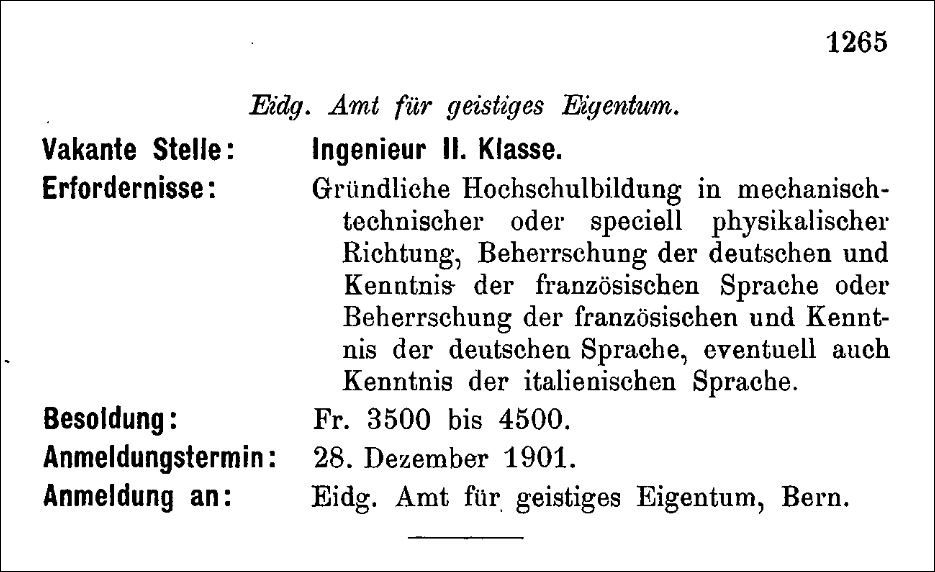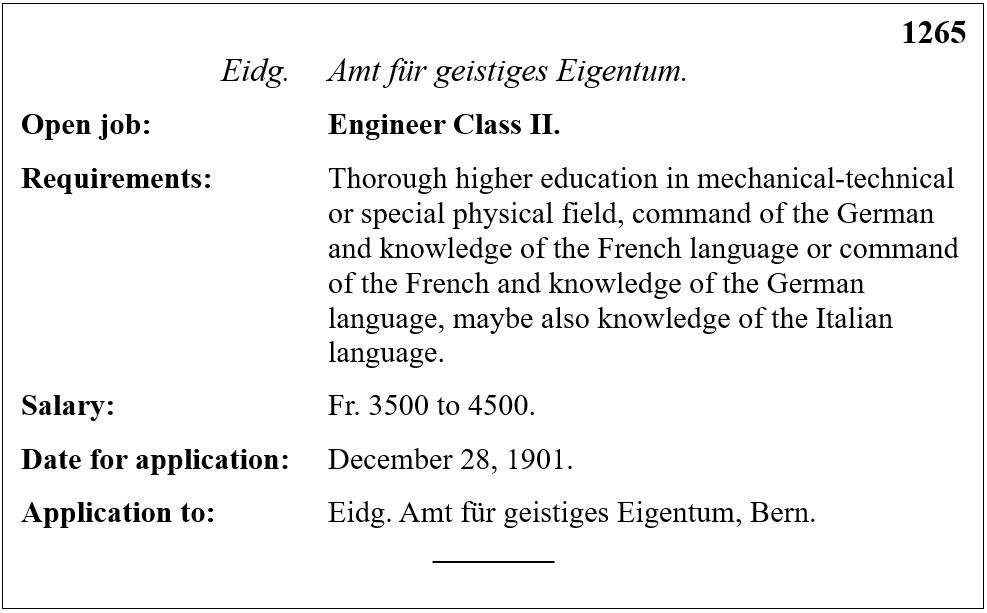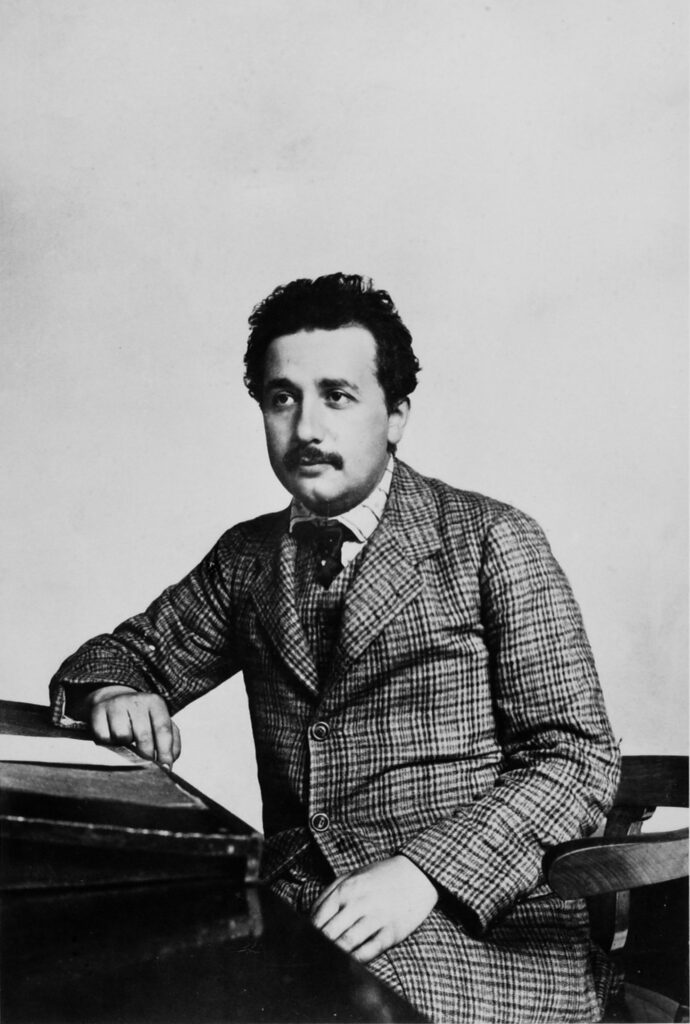“It interested me immensely that you want to return to the Patent Office again, into that worldly cloister where I concocted my finest ideas and where we lived through such nice times together. […]”
Albert Einstein to his friend Michele Besso, December 12, 1919
Albert Einstein and the Patent Office in Bern
To the Patent Office:
Founded on November 15, 1888
From 1888 to 1979: “Eidgenössisches Amt für geistiges Eigentum“, in common parlance the office was often called “Patent Office“
From 1979 to 1996: “Bundesamt für geistiges Eigentum“
Since January 1, 1996: “Eidgenössisches Institut für Geistiges Eigentum (IGE)“
Because of the suggestion of his friend and former fellow student Marcel Grossmann (1878-1936), Albert Einstein applied for a job at the Patent Office in Bern. Marcel’s father, Jules Grossmann (1843-1934), who personally knew the Mechanical Engineer and first Director of the Patent Office, Friedrich Haller (1844-1936), had recommended Einstein.
On April 14, 1901, Einstein wrote a letter to Marcel Grossmann and thanked him for the recommendation of his father towards Friedrich Haller: “[…] Please give my kindest regards to your dear family and my warm thanks to your father for his efforts and the trust he had shown by recommending me.“
On December 11, 1901, the following advertisement was published in the Swiss Federal Gazette:


On December 19, 1901, Einstein informed Mileva Maric that Haller had written him a personal, friendly letter a few days ago, asking him to immediately apply for a newly created job at the Patent Office.
And Einstein did. On December 18, 1901, he applied for the advertised job with a letter to “Eidgenössisches Amt für geistiges Eigentum“. In his application, he writes: “I, the undersigned, take the liberty of applying for the position of Engineer Class II at the Federal Office for Intellectual Property, which was advertised in the Bundesblatt [Federal Gazette] of 11 December 1901. I obtained my professional education in physics and electrical engineering at the School for Specialist Teachers of Mathematics and Physics at the Federal Polytechnikum in Zurich, […]” In the further course of the letter he describes his professional career. At this time, Einstein still lived and worked in Schaffhausen.
In January 1902, Lieserl, the illegitimate daughter of Albert Einstein and Mileva Maric, his former fellow student, was born in Hungary.
At the beginning of February 1902, Einstein moved from Schaffhausen to Bern. The decision of the Patent Office with regard to the job assignment delayed. His financial situation forced him to live in an extremely modest way. However, to earn his living until a possible assumption of office in the Patent Office, he posted an advertisement in the gazette of the city of Bern. He offered private lessons in Physics and Mathematics for pupils and students. This led to the later development of the “Akademie Olympia“ in Bern.
In June 1902, his time came. On June 19, 1902, Einstein finally received the long-awaited confirmation from the Patent Office. In the letter, it says: “[…] At its session of 16 June 1902, the Federal Council elected you provisionally as a Technical Expert Class III of the Fed. Office for Intellectual Property with an annual salary of 3,500 fr.”
In addition to Einstein, also J. Heinrich Schenk was temporarily, i.e. on trial, selected by the Bundesrat [Swiss government], to be a Technical Expert Class III.
Thus, Einstein did no longer have any financial worries.
Albert Einstein‘s first working day was Monday, June 23, 1902. At this time, the Patent Office was located on the upper floors of the telegraph building at the corner Speichergasse/Genfergasse. Here, he worked in room 86 on the third floor at his desk, sometimes also at his lectern, and examined inventions for their patentability.
When new civil servants started to work, the Director of the Office respectively let them take an oral and written test which could last up to two days. Among other things, Director Haller taught the new civil servants technical subjects. He was a taskmaster and was considered an undisputed authority in the Office. “Einstein honestly appreciated the robust, but at the same time kind and logic-consequent, characterful nature of his superior.“ Haller, who was an excellent methodologist, made it clear to his employees what they should first think of a patent application: that everything was wrong with it! They should be critical and attentive. Only then, the invention should be questioned and examined. Haller’s method had shaped young Einstein very much and had sharpened his thinking. According to Einstein‘s own words, this kind of work had been very useful for his further development.
“Einstein stayed at the Patent Office for more than one year (provisional arrangement). As 42nd civil servant, he was under strict control and was ordered to fulfil his duties conscientiously. He had to learn how to read technical drawings and entered measurements. Because of his easy and quick comprehension, the work at the Office was not hard for Einstein, and he often solved difficult problems. Einstein felt happy with his fix, regular salary. Through his behavior, the externally so modestly seeming civil servant more and more gained the appreciation of his superiors and the respect of his colleagues. Also the former and very strict Director of the Patent Office, Friedrich Haller, appreciated his work.
Though always polite and courteous by his nature, correct towards everybody, and without bourgeoisie, Einstein still preserved his free will and his golden humor at the Patent Office. As special expert of Maxwell’s Theory, Einstein was primarily occupied with patents that had to do with electrical appliances.“
Source: “Albert Einsteins Berner Jahre”, A. Meichle
The “42nd civil servant“ who is mentioned in the above text, refers to the fact that Einstein was listed in the files of the Office as 42nd civil servant.

Today, it cannot be determined any longer and in any more detail which patents Einstein had been working on. However, in case of the following patents it is assumed that they were personally examined by Einstein:
Patent no. 39561: Gravel sorter
Patent no. 39619: Meteorological station controlled by ambient humidity
Patent no. 39853: Electrical typewriter with shuttle-type carrier
Supplementary patent no. 39988 (to main patent no. 38853):
Alternative-current commentator motor with short-circuit brushes and opposite-mounted auxiliary coils for spark suppression
Objections to Alternative-current commentator motor
Source: IGE
On January 6, 1903, Albert Einstein married his former fellow student Mileva Maric – against the will of the families. Somewhat more than one year later, their first son Hans Albert was born on May 14, 1904. Since the autumn of 1903, the family had been living in Bern in Kramgasse 49.
In the first years, Einstein drew an annual salary of Fr. 3500. The civil servants had to confirm their salary on a joint list. Thus, each civil servant knew the salary of the other civil servants. This list also contained the salary of the Director. The work in the Office was not hard for Einstein. Through his quick comprehension, his combinative thinking, and the ability to express himself clearly and correctly, he was able to easily immerse in patent applications, and to often solve difficult problems in short and acceptable time. Towards friends, he was told to describe his work in the Office, corresponding to his humor, as “cobbler’s trade“. Director Haller appreciated his employee very much, not only from an expert point of view, but also because of his behavior and unassuming appearance. Also by his colleagues he was more and more appreciated.
Einstein knew how to exactly apportion his time: eight hours work in the Patent Office, eight hours “Allotria“ (essentially means fun or enjoyable nonsense) connected with scientific work, and eight hours of sleep. The latter was often used for further scientific work and for creating scientific manuscripts.
Despite the work in the “worldly cloister” he found the time, in his maybe physically most creative period, to continue working on Theoretical Physics, especially in the year of greatness 1905, his “annus mirabilis”. In this year, he published four groundbreaking papers in the Annalen der Physik [Annals of Physics] which revolutionize the basics of Physics around 1900. One of the papers, Zur Elektrodynamik bewegter Körper [On the electrodynamics of moving bodies], contains the special theory of relativity. In another paper, he develops the famous formular E = mc2. With some colleagues of the Patent Office, for example Dr. Josef Sauter and Michele Besso, he talked about and discussed constructively, mostly on the way to the Office or on the way back, his revolutionizing theories, thus also his theory of relativity. Since 1904, Michele Besso had been an colleague of Einstein in the Patent Office. They had a lifelong friendship.
Einstein probably had notes of his respectively current physical theories in the drawer of his desk in the Office, so that he could have a look at them from time to time.
In April 1905, Einstein submitted his work, Eine neue Bestimmung der Moleküldimensionen [On a new determination of molecular dimensions], as dissertation at the University of Zurich, which was accepted at the end of July. In the middle of January, Einstein was graduated by the University of Zurich.
On April 1, 1906, Einstein was promoted to be a Technical Expert Class II with an annual salary of Fr. 4500. According to the payroll, the Director, Friedrich Haller, earned at this time Fr. 8000 per year. When Einstein learned about his salary increase, he is said to have asked the Director what he should do with all the money. Einstein’s financial situation was more than safe.
From 1907 to 1921, the Patent Office was located in the old postal building at “äußeres Bollwerk” (Bollwerk No. 8). Here, Einstein worked on the first floor in very comfortable spatial conditions.
In the meantime, also the physical world had taken note of the young, still unknown Albert Einstein.
Thus, Carl Seelig describes in his Einstein biography a discussion between him and the German physicist Max von Laue (1879-1960) about meeting Albert Einstein (1907) in the Patent Office in Bern: “According to what we agreed in the letter, I [Max von Laue] met him in the “Amt für geistiges Eigentum”. In the general reception room, a civil servant told me to go on the corridor again, Einstein would meet me there. I did this, but the young man who approached me made such an unexpected impression that I did not believe that he could be the father of the theory of relativity. Thus, I let him pass, and only when he went back from the reception room we met each other. I just know details of what we talked about. But I remember that the cheroot which he offered me tasted so bad that I let it “accidentally” fall from the Aare bridge down into the Aare.“
After presentation of a postdoctoral thesis and a test lecture, Einstein became a private lecturer at the University of Bern on February 28, 1908. In the letter of the university it says: “Pursuant to your petition of June 1907, and based on the expert opinion of the Philosophical Faculty, we grant you, as prescribed by law, the venia docendi for theoretical physics, and invite you to start your academic activity with an inaugural lecture, […]“
In addition to his work at the Patent Office, Einstein began to lecture at the University of Bern, however, this did not completely satisfy the young lecturer. With the support of friends, for example Michele Besso, Josef Sauter, and Lucien Chavan, contact was made with the University of Zurich. As the negotiations with the University of Zurich developed positively, and he subsequently received an appointment as Professor of Theoretical Physics at the University of Zurich, Einstein handed in his notice on July 6, 1909 to the Eidg. Justiz- & Polizei-Departement, Bern. He writes: “The undersigned has been appointed Professor of Theoretical Physics at the University of Zurich by the Zurich Cantonal Council and has accepted this appointment. For that reason he requests that you release him from his current position as Technical Expert at the Patent Office effective 15 October 1909. […]”
Director Haller and the Office let Einstein only go reluctantly. Towards the Bundesrat [Swiss government] he said on July 12, 1909: “Dr. A. Einstein, an Expert at the Office since 1902, has performed very valuable services for it. His departure is a setback for the Office. Nevertheless, Mr. Einstein feels that the teaching profession and scientific research are his true calling, which is why the Director of the Office had to refrain from making attempts to attach him to the Office by financial promotion.”
Albert Einstein left the Patent Office on October 15, 1909, and the city of Bern only some days later.
He and his family moved to Zurich. There, he started to teach with the beginning of the winter semester at the university on October 18.
Leaving Bern also meant a new beginning for Einstein. The young civil servant at the Patent Office Albert Einstein should become one of the greatest natural scientists of his time.
03/2024
Illustrations Credits:
Eidgenössisches Institut für Geistiges Eigentum (IGE), Inserat (BBl 1901 IV 1264 ff., 1265): 1
Archive of the author: 2
Public Domain: 3
Bibliography:
| Hrsg. John Stachel, David C. Cassidy, Robert Schulmann | The Collected Papers of Albert Einstein, Volume 1 | Princeton 1987 |
| Hrsg. Martin J. Klein, A. J. Kox, Robert Schulmann | The Collected Papers of Albert Einstein, Volume 5 | Princeton 1993 |
| Hrsg. Diana Kormos Buchwald, Robert Schulmann, József Illy | The Collected Papers of Albert Einstein, Volume 9 | Princeton 2004 |
| Max Flückiger | Albert Einstein in Bern | Bern, 1974 |
| Albrecht Fölsing | Albert Einstein – Eine Biographie | Frankfurt / Main 1993 |
| Ann M. Hentschel, Gerd Graßhoff | Albert Einstein “Those Happy Bernese Years” | Bern, 2005 |
| A. Meichle | Albert Einsteins Berner Jahre 1902-1909 | Bern, 1992 |
| Carl Seelig | Albert Einstein | Zurich, 1954 |
| Claudia E. Graf-Grossmann | Marcel Grossmann – Aus Liebe zur Mathematik | Zurich, 2015 |


 DEUTSCH
DEUTSCH